| ________________
CM . . . . Volume XXI Number 28 . . . . March 27, 2015

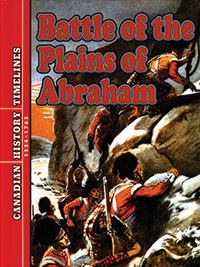
|
Battle of the Plains of Abraham. (Canadian History Timelines: 1534-1763).
Blaine Wiseman.
Calgary, AB: Weigl Educational Publishers, 2015.
32 pp., pbk., hc. & ebook, $13.95 (pbk.), $24.95 (RLB), $35.95 (ebook).
ISBN 978-1-4872-0013-8 (pbk.), ISBN 978-1-4872-0012-1 (RLB), ISBN 978-1-4872-0014-5 (ebook).
Grades 5-8 / Ages 10-13.
Review by Ian Stewart.
*** /4
|
| |
|
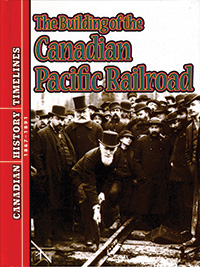
|
The Building of the Canadian Pacific Railroad. (Canadian History Timelines: 1867-1891).
Blaine Wiseman.
Calgary, AB: Weigl Educational Publishers, 2015.
32 pp., pbk., hc. & ebook, $13.95 (pbk.), $24.95 (RLB), $35.95 (ebook).
ISBN 978-1-4872-0022-0 (pbk.), ISBN 978-1-4872-0021-3 (RLB), ISBN 978-1-4872-0023-7 (ebook).
Grades 5-8 / Ages 10-13.
Review by Ian Stewart.
*** /4
|
| |
|
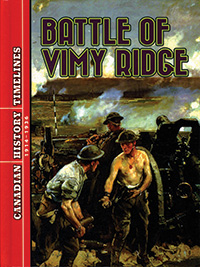
|
Battle of Vimy Ridge. (Canadian History Timelines: 1914-1936).
Blaine Wiseman.
Calgary, AB: Weigl Educational Publishers, 2015.
32 pp., pbk., hc. & ebook, $13.95 (pbk.), $24.95 (RLB), $35.95 (ebook).
ISBN 978-1-4872-0019-0 (pbk.), ISBN 978-1-4872-0018-3 (RLB), ISBN 978-1-4872-0020-6 (ebook).
Grades 5-8 / Ages 10-13.
Review by Ian Stewart.
*** /4
|
| |
|
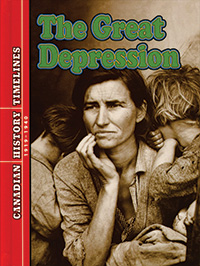
|
The Great Depression. (Canadian History Timelines: 1919-1940).
Blaine Wiseman.
Calgary, AB: Weigl Educational Publishers, 2015.
32 pp., pbk., hc. & ebook, $13.95 (pbk.), $24.95 (RLB), $35.95 (ebook).
ISBN 978-1-4872-0016-9 (pbk.), ISBN 978-1-4872-0015-2 (RLB), ISBN 978-1-4872-0017-6 (ebook).
Grades 5-8 / Ages 10-13.
Review by Ian Stewart.
*** /4
|
| |
|

excerpts:
The battle of the Plains of Abraham changed the direction of Canadian history forever. It gave control of North America to Great Britain. The British expanded throughout the continent. It redrew its borders and shaped Canada into the nation it would become. (From The Battle of the Plains of Abraham.)
John A McDonald's dream of a united Canada was difficult to achieve. He fought rebellions, risked bankrupts and even lost his job as prime minister. By being persistent and relying on help from Canadians and others around the world, he reached his goal. Thanks to the Canadian Pacific Railway, Canada stretches across the continent united as one nation. (From The Canadian Pacific Railroad.)
Innovations made by Canadian leaders, as well as sacrifices made by their soldiers, surprised the world. They helped the Allies win the war. When Canada went to war in 1914, it was a small part of the British Commonwealth. The Canadians who fought at Vimy Ridge did more than help win the war. Their sacrifices and courage made the world recognize Canada as a nation of its own. (From The Battle of Vimy Ridge.)
The Great Depression was a devastating time for Canadians. People across the country lost their jobs, their homes and their belongings. More importantly, they did not lose hope. Through their struggles, Canadians came together to make important changes to the country. Canadians can still see many of these changes today. (From The Great Depression.)
The titles in this new series draw students' attention to four important pivot points in Canadian history: the English conquest of New France, the building of the transcontinental railway, the First World War and the Battle of Vimy Ridge and the Great Depression of the 1920s and 1930s. Each of the historical dramas examined permanently and significantly altered the direction of Canada's story.
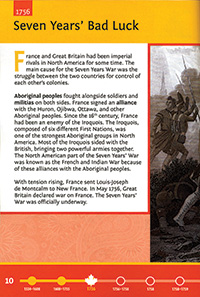 Students will see that Canadian history does not follow an unwavering path, but rather internal and external political, social and economic forces, along with the actions of determined individuals, changed and created the country we live in to day. Canada's history, they will also see, was not always pretty: there was war, racism, poverty, suffering political intransigence and incompetence.
Students will see that Canadian history does not follow an unwavering path, but rather internal and external political, social and economic forces, along with the actions of determined individuals, changed and created the country we live in to day. Canada's history, they will also see, was not always pretty: there was war, racism, poverty, suffering political intransigence and incompetence.
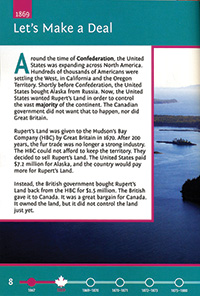 The English victory on the Plains of Abraham and the final conquest of New France, in 1763, created the possibility of Canada as British immigration redefined its borders and introduced new political systems, but also the linguistic divide that still affects Canada today. After the fits and starts that led to confederation and the creation of the Dominion of Canada in 1867, Sir John A. McDonald was determined to create a new nation as our national motto says, A mari usque ad mare. Students will see that this was a long hard task to accomplish and that it was unfair to First Nations peoples and Chinese immigrant workers, but it opened the great northwestern territory to settlement and development. Canada entered the maelstrom of the industrialized First World War (1914-1918) because of its obligations to the British Empire. At the beginning of the war, the Canadian Expeditionary Force was small, untrained and ill disciplined, but, by 1917, it showed evidence of becoming the elite shock troops of the allied armies and proved itself at Vimy Ridge and so gained the respect of the Great Powers and led to Canada's becomimg a truly independent country in the following decades. After the war, the prosperity of the 1920s ended and the decade of the world wide Great Depression came to Canada. Canadian politicians and institutions were ill equipped to deal with the economic and social calamity that engulfed the country. New political parties were formed, and governments looked for solutions and instituted parts of the social safety net that forms part of our social fabric today.
The English victory on the Plains of Abraham and the final conquest of New France, in 1763, created the possibility of Canada as British immigration redefined its borders and introduced new political systems, but also the linguistic divide that still affects Canada today. After the fits and starts that led to confederation and the creation of the Dominion of Canada in 1867, Sir John A. McDonald was determined to create a new nation as our national motto says, A mari usque ad mare. Students will see that this was a long hard task to accomplish and that it was unfair to First Nations peoples and Chinese immigrant workers, but it opened the great northwestern territory to settlement and development. Canada entered the maelstrom of the industrialized First World War (1914-1918) because of its obligations to the British Empire. At the beginning of the war, the Canadian Expeditionary Force was small, untrained and ill disciplined, but, by 1917, it showed evidence of becoming the elite shock troops of the allied armies and proved itself at Vimy Ridge and so gained the respect of the Great Powers and led to Canada's becomimg a truly independent country in the following decades. After the war, the prosperity of the 1920s ended and the decade of the world wide Great Depression came to Canada. Canadian politicians and institutions were ill equipped to deal with the economic and social calamity that engulfed the country. New political parties were formed, and governments looked for solutions and instituted parts of the social safety net that forms part of our social fabric today.
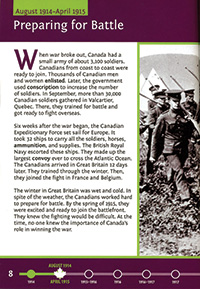 The chapters are well-written, provide adequate information, introduce the story's main characters and are succinctly laid out, according to the chronological "timeline" that accompanies each page. Also, the chapter titles, themselves, are imaginatively named to drive the historical story forward and stimulate student interest, as we see in The Building of the Canadian Pacific Railroad: "A Train Wreck", "Back on the Rails", "Full Steam Ahead"; and from The Great Depression: "The Roaring Twenties", "Crash and Burn", "A New King on the Hill". On the last pages of the text, students will find a Brain Teaser quiz and "Further Information" which sadly only lists YouTube and internet resources.
The chapters are well-written, provide adequate information, introduce the story's main characters and are succinctly laid out, according to the chronological "timeline" that accompanies each page. Also, the chapter titles, themselves, are imaginatively named to drive the historical story forward and stimulate student interest, as we see in The Building of the Canadian Pacific Railroad: "A Train Wreck", "Back on the Rails", "Full Steam Ahead"; and from The Great Depression: "The Roaring Twenties", "Crash and Burn", "A New King on the Hill". On the last pages of the text, students will find a Brain Teaser quiz and "Further Information" which sadly only lists YouTube and internet resources.
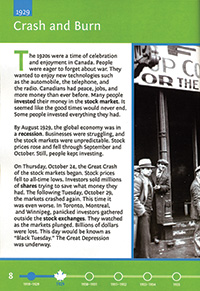 There are, unfortunately, some anachronistic errors: during the Depression, the unemployed could receive Unemployment Insurance not Employment Insurance (1996); Canada was part of the British Empire during World War I, not the Commonwealth, which was created in 1931 and was when Canada became truly independent of Britain; Canada was a British colony in 1763, it did not become a Dominion, or a self governing nation, until 1867.
There are, unfortunately, some anachronistic errors: during the Depression, the unemployed could receive Unemployment Insurance not Employment Insurance (1996); Canada was part of the British Empire during World War I, not the Commonwealth, which was created in 1931 and was when Canada became truly independent of Britain; Canada was a British colony in 1763, it did not become a Dominion, or a self governing nation, until 1867.
Recommended.
Ian Stewart teaches at Cecil Rhodes School in Winnipeg, MB, and is happy to donate the books he reviews to the Cecil Rhodes Library.
 To comment on this title or this review, send mail to cm@umanitoba.ca.
To comment on this title or this review, send mail to cm@umanitoba.ca.
Copyright © the Manitoba Library Association. Reproduction for personal use is permitted only if this copyright notice is maintained. Any other reproduction is prohibited without permission.
Next Review |
Table of Contents for This Issue
- March 27, 2015.
CM Home
| Back Issues
| Search
| CM Archive
| Profiles Archive
|




 Students will see that Canadian history does not follow an unwavering path, but rather internal and external political, social and economic forces, along with the actions of determined individuals, changed and created the country we live in to day. Canada's history, they will also see, was not always pretty: there was war, racism, poverty, suffering political intransigence and incompetence.
Students will see that Canadian history does not follow an unwavering path, but rather internal and external political, social and economic forces, along with the actions of determined individuals, changed and created the country we live in to day. Canada's history, they will also see, was not always pretty: there was war, racism, poverty, suffering political intransigence and incompetence.
 The English victory on the Plains of Abraham and the final conquest of New France, in 1763, created the possibility of Canada as British immigration redefined its borders and introduced new political systems, but also the linguistic divide that still affects Canada today. After the fits and starts that led to confederation and the creation of the Dominion of Canada in 1867, Sir John A. McDonald was determined to create a new nation as our national motto says, A mari usque ad mare. Students will see that this was a long hard task to accomplish and that it was unfair to First Nations peoples and Chinese immigrant workers, but it opened the great northwestern territory to settlement and development. Canada entered the maelstrom of the industrialized First World War (1914-1918) because of its obligations to the British Empire. At the beginning of the war, the Canadian Expeditionary Force was small, untrained and ill disciplined, but, by 1917, it showed evidence of becoming the elite shock troops of the allied armies and proved itself at Vimy Ridge and so gained the respect of the Great Powers and led to Canada's becomimg a truly independent country in the following decades. After the war, the prosperity of the 1920s ended and the decade of the world wide Great Depression came to Canada. Canadian politicians and institutions were ill equipped to deal with the economic and social calamity that engulfed the country. New political parties were formed, and governments looked for solutions and instituted parts of the social safety net that forms part of our social fabric today.
The English victory on the Plains of Abraham and the final conquest of New France, in 1763, created the possibility of Canada as British immigration redefined its borders and introduced new political systems, but also the linguistic divide that still affects Canada today. After the fits and starts that led to confederation and the creation of the Dominion of Canada in 1867, Sir John A. McDonald was determined to create a new nation as our national motto says, A mari usque ad mare. Students will see that this was a long hard task to accomplish and that it was unfair to First Nations peoples and Chinese immigrant workers, but it opened the great northwestern territory to settlement and development. Canada entered the maelstrom of the industrialized First World War (1914-1918) because of its obligations to the British Empire. At the beginning of the war, the Canadian Expeditionary Force was small, untrained and ill disciplined, but, by 1917, it showed evidence of becoming the elite shock troops of the allied armies and proved itself at Vimy Ridge and so gained the respect of the Great Powers and led to Canada's becomimg a truly independent country in the following decades. After the war, the prosperity of the 1920s ended and the decade of the world wide Great Depression came to Canada. Canadian politicians and institutions were ill equipped to deal with the economic and social calamity that engulfed the country. New political parties were formed, and governments looked for solutions and instituted parts of the social safety net that forms part of our social fabric today.
 The chapters are well-written, provide adequate information, introduce the story's main characters and are succinctly laid out, according to the chronological "timeline" that accompanies each page. Also, the chapter titles, themselves, are imaginatively named to drive the historical story forward and stimulate student interest, as we see in The Building of the Canadian Pacific Railroad: "A Train Wreck", "Back on the Rails", "Full Steam Ahead"; and from The Great Depression: "The Roaring Twenties", "Crash and Burn", "A New King on the Hill". On the last pages of the text, students will find a Brain Teaser quiz and "Further Information" which sadly only lists YouTube and internet resources.
The chapters are well-written, provide adequate information, introduce the story's main characters and are succinctly laid out, according to the chronological "timeline" that accompanies each page. Also, the chapter titles, themselves, are imaginatively named to drive the historical story forward and stimulate student interest, as we see in The Building of the Canadian Pacific Railroad: "A Train Wreck", "Back on the Rails", "Full Steam Ahead"; and from The Great Depression: "The Roaring Twenties", "Crash and Burn", "A New King on the Hill". On the last pages of the text, students will find a Brain Teaser quiz and "Further Information" which sadly only lists YouTube and internet resources.
 There are, unfortunately, some anachronistic errors: during the Depression, the unemployed could receive Unemployment Insurance not Employment Insurance (1996); Canada was part of the British Empire during World War I, not the Commonwealth, which was created in 1931 and was when Canada became truly independent of Britain; Canada was a British colony in 1763, it did not become a Dominion, or a self governing nation, until 1867.
There are, unfortunately, some anachronistic errors: during the Depression, the unemployed could receive Unemployment Insurance not Employment Insurance (1996); Canada was part of the British Empire during World War I, not the Commonwealth, which was created in 1931 and was when Canada became truly independent of Britain; Canada was a British colony in 1763, it did not become a Dominion, or a self governing nation, until 1867.